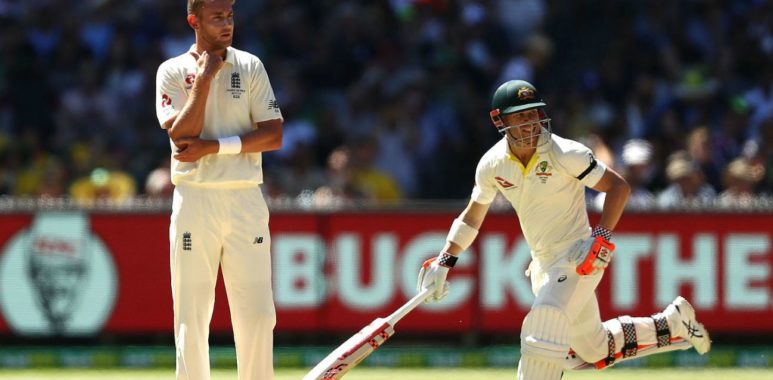
David Warner eyes Stuart Broad rematch after paceman’s recall
Stuart Broad‘s Ashes batting bunny David Warner is still trying to figure out how it was even possible that the paceman was dropped from England’s first Test match of the northern summer, and paid tribute to the 34-year-old as he stood on the brink of 500 wickets.
In getting out seven times in 10 innings to Broad in England last year, Warner had a previously respectable record in England scythed down to an embarrassing size. The Australian was left questioning plenty about himself and his game in foreign conditions before he returned home to a typically bountiful home season against Pakistan and New Zealand.
Warner admitted to some shock when he saw that Broad was left out for Mark Wood when England played the first Test match since cricket’s return amid the coronavirus pandemic, before the Nottinghamshire seamer was recalled and proved instrumental in securing the hosts victory in the second match of the series and then taking the hosts to the outskirts of another in the decider.
“I think they should not drop him again, I don’t know why they dropped him for that first game,” Warner laughed. “It’d be nice if I was to play over there again and he wasn’t playing. I saw he got a 50 and he’s taking some batting tips off Shane Warne, which is weird, but the way he bowls, the way he’s been bowling the last 18 months has been outstanding. I don’t know what was the reasoning behind leaving him out of that first Test, but obviously he’s come back and taken a few wickets.
“Personally, I think he’s a world-class bowler and the last 18 months he’s really worked hard on pitching the ball up. When I look back on the stats it is probably the first time in his career, he’s actually pitched the ball up in that sort of five to six metres area the bowlers talk about quite a lot. He’s got a hell of a record against left handers as well, and I think the capability of him bringing the ball back off the wicket into the left handers has been another string to his bow.
“Bowlers do tend to talk about not meaning to do that off the seam, but if you keep producing the right seam consistently enough, you’re going to get that sideways movement both ways and he’s been able to get that, and it’s not by fluke that he’s had success the past 18 months, he’s worked really hard to get to where he is and credit to him. Hopefully, yeah, I do get another crack against him.”
“They’re both not express pace, and to take [nearly 1100] wickets between them as a pair when playing together is exceptional. You just can’t go after them, they don’t take their foot off the pedal and when you’re up against them, you’ve got to think of ways to rotate strike.”
Warner on the enduring Broad-Anderson partnership
The sequence of dismissals endured by Warner last year was testament to Broad’s ability to improve himself, having previously struggled to find the right lines and lengths with which to challenge the Australian left-hander, either in challenging Australian conditions or even friendlier home environs during the 2013 and 2015 series. Broad made his own disappointment plain during the first Test against the West Indies in Hampshire, but in the final match of the series at Old Trafford, he has returned to a familiar and prolific partnership with James Anderson.
“I think when you’ve got two quality bowlers who’ve bowled in partnerships for a long, long time, in the partnership they bowl they don’t leak runs, and that’s the most important thing when we bat in partnerships, we try to get off strike, rotate strike, get bowlers off their lines and lengths,” Warner said. “These guys have the ability to keep those runs restricted, and they bowl a length where in England if you go to drive that length, you’re probably going to nick, but also the length means they’re still hitting the stumps, so you can’t really leave it.
“In English conditions they just know how to get wickets and how to not leak runs. I know as well, James Anderson can not take a wicket, but still go for less than two an over. That just shows his experience as well. They’re both not express pace, and to take [nearly 1100] wickets between them as a pair when playing together is exceptional. You just can’t go after them, they don’t take their foot off the pedal and when you’re up against them, you’ve got to think of ways to rotate strike. Otherwise if you give them too many overs at you, they’re going to get you out.”

